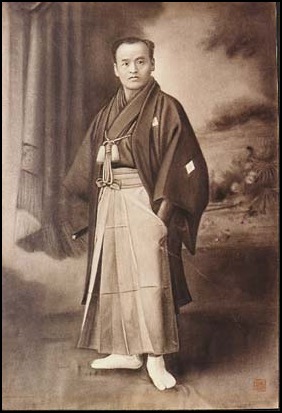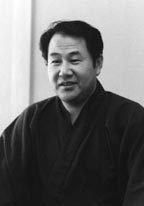An Overview History of Daito Ryu Aikijutsu
By Scott Shaw
Author's Note:
Daito Ryu was the primary influence for the formation of Hapkido. Therefore, the history of Daito Ryu is an essential element to understanding the birth of Hapkido.
The systems of martial arts which were developed in Japan have been driven to the forefront of modern understanding primarily at the hands of the media. Certainly, the acts of the Kamikaze pilots of World War II will live throughout history in infamy. But, it is no doubt the stylings of the Japanese Samurai Swordsmen—as have been depicted in an untold number of televisions programs and movies, that has etched the image of the Japanese martial arts onto the minds of the masses.
Though little is written about the initial formation of martial culture in Japan, this nation historically traces the foundations of its martial arts to early contact with Korea and China. From these ancient contacts, and the influences provided by these two cultures, Japan set about on a course of taking what it had learned, redefining this knowledge, and then developing its own systems of self-defense which more exactly emulate Japanese society. This was a long process, beginning in appropriately the fifth century B.C.E., and continuing forward until Samurai culture firmly took hold during the eleventh and twentieth centuries of the common era.
Before the study of Daito Ryu can begin, it must be noted that there have been over five thousand Ryu or "Schools of Martial Arts" uniquely identified as having existed in Japan. The techniques of these various schools were made up of hand-to-hand combat and many used various weapons, most particularly the sword, as an additional means of self-defense. As such, though many of the schools had and have similar techniques, just as many possess techniques which were vastly different from other schools of their era. Thus, it can be understood that there has never been one singular method of martial arts in Japan. Due to this fact, one should never judge the techniques of a practitioner of one system as being any less valid that that of another.
Certain Japanese schools of self-defense, such as Shotokan or Judo, have stepped to the forefront, defining the modern Japanese martial arts. Other schools, such as Daito Ryu, are no less important, however, in understanding the plethora of techniques formulated and practiced in Japan.
Daito Ryu Aikijutsu
Daito Ryu Aikijutsu was founded by Goto Tamauemon Tadayoshi (1677-1736). He was born to the Aizu clan—known as fierce warriors who drew their heritage from Tokugawa Shogunate.
The Aizu system of martial arts was based in Chu Hsi—a Neo-Confucian doctrine, known as, "Aiki In Yo Ho." This was an understanding of universal harmony based in the Chinese concept of Yin and Yang. This understanding was heartily embraced and formed the basis for the Aizu understanding of Bushido, Code of the Warrior.
The Aizu trained in the various weapons common to the era. The primary school of combat which they were schooled in was that of Mizuno Shinto Ryu. The hand-to-hand techniques which made up their training was known as Oshikiuchi.
This system of martial arts was passed down through the centuries, via affluent clan members of high birth, until elements of this system were taught to an individual who would usher it into the twentieth century, Takeda Sokaku.
Takeda Sokaku

Takeda Sokaku (1859 - 1943) though standing barely five feet tall, first came to prominence in Japan as an expert swordsman in an era when carrying the samurai sword was looked down upon and eventually banned in 1876. Takeda Sokaku was born the second son of Takeda Sokichi on 10 October 1859 in the Oike region of Aizu, Japan—now a part of present-day Fukushima Prefecture.
Takeda martial art training began in the Onoha Itto Ryu method of Kenjitsu. He was taught by Shibuya Toma, a friend of his father. In 1873, at the age of fifteen, Takeda relocated to the dojo of another friend of his father, famed swordsman, Sakakibara Kenkichi. Once there, Takeda immersed himself in the study of Sakakibara's style of Jikishin Kage Ryu. He eventually mastered many different weapons including: the sword (ken), the staff (bo), the half-bow (hankyu), the short-staff (jo), and the throwing stars (shuriken).
During this period of his life, Takeda had the opportunity to meet and train with many of the top swordsmen of his day. As the era of the Samurai was coming to an end, many of these individuals were displaced swordsmen who once had been retainers of the Tokugawa Shogunate's and had studied at the famed Kobusho. Kobusho was the exclusive training school for the Japanese warriors. This institute may be compared to modern day, West Point.
Takeda stated that it was not until he trained in Jikishin Kage Ryu, that he truly became proficient with the sword. From this training he eventually was awarded instructors licenses in Onoha Itto Ryu and Hozoin Ryu.
In his early twenties, Takeda inspired by the Samurai he had met while training under Sakakibara Kenkichi, began to travel Japan—testing his swordsmanship against technicians from other schools. When he was twenty-three he was almost killed in a street brawl against a large unruly crowd of construction workers, who taunted his sword and old style of dress in Tokyo. Though he killed several of them, it was a policeman who luckily came upon the scene and stopped the mob from killing the young Takeda—who lay bleeding and unconscious upon the ground. Though the foreman of the construction crew pressed charges against Takeda, for provoking the fight, as he was the only one with a sword, the charges were eventually dismissed. Takeda was informed by the judge, however, that the era of carrying a sword was over. That the only reason the altercation had begun was due to the fact that Takeda walked the streets unlawfully carrying his katana. This statement, however, did not faze the young Takeda, and he continued his escapades for many more years. Legend states that his sword fighting skills were unparalleled, so much so that he was known as, "The Little Tengu of Aizu" In Japanese, a Tengu is a mythical long-nosed demon.
Similar to many Samurai of his era, Takeda was a deeply religious man. This inclination led him to spend much time meditating, praying, and practicing various forms of asceticism at temples located in sacred locations throughout Japan; including: Mt. Futara in the Nikko Prefecture, Udomyojin in the Kyushu Prefecture, and Mt. Haguro in the Akita and Yamagata Prefectures, formerly the Dewa Province.
Though a master of the sword, Takeda would not beginning training in the hand-to-hand combat of Daito Ryu Aikijitsu until several years later, when in 1875, Takeda's spiritual calling led him to the Tsutsukiwake Shrine in Fukushima. He hoped to study there and eventually becoming a Priest. Though this never came to pass, Takeda did meet Saigo Tanomo.
Saigo Tanomo had been a Chief Counsel for the Aizu Clan until the Meji Restoration, which, in essence, put an end to the era of the Samurai. In 1868, Tanomo had became a Shinto priest and his name was changed to Hoshina Chikanori. Though now a priest, Chikanori was a famed trainer of warriors.
Due to Takeda's reputation as a swordsman, he was allowed to study Daito Ryu from Chiknori. Under his tulage, Takeda learned the secret art of hand-to-hand combat, once only taught to the elite Aizu Samurai. Due to his proficiency with weapons, Takeda quickly mastered this system of self-defense.
On 12 May 1898, shortly before his death, Chikanori presented Takeda with a single poem. The writing of a poem, from master to student, was a common tradition among Japanese martial artists of this era, signify accomplishment. In this poem, Chikanori states, "The begining of the Meji Period ended the age of the sword. No longer can a great swordsman leave his mark on society. Now it is time for you to pursue and make you way with Jujitsu." Thus, Takeda was given permission to teach Daito Ryu.
Takeda Sokaku has gone down in history as the, "Chuko no so," Reviver of Daito Ryu. For the rest of his life, Takeda taught Daito Ryu. It is known that he taught as many as thirty-thousand people during his lifetime. The names, signatures, and seals of everyone he taught is listed in his enrollment books which are preserved to this day.
Takeda was married and had seven children. His wife died in 1930. Post the death of Takada, on 25 April 1943, the named successor to Daito Ryu was his first son, Tokimune Takeda (1913-1993).
During his lifetime, Takeda Sokaku never awarded Black Belt or Dan ranks. He only awarded Assistant Instructor or Instructor Certification—which were all hand inscribed by Takeda himself. His son, Tokimune Takeda, is the one who introduced Dan ranks into the curriculum of Daito Ryu.
After Tokimune Takeda's death, Dairi Katsuyuki Kondo was appointed as the leader of Takada's system of Daito Ryu in 1994 by a committee made up of the leaders from the various branch schools in Japan. In 1995 he was fully recognized as the leader of Daito Ryu by the Nihon Kobudo Kyokai, "Japan Kobudo Association" and the Nihon Kobudo Shinkokai, "Society for the Promotion of Japanese Kobudo." He maintains control over the teachings to this day.
Copyright © 1990 & 1995 — All Rights Reserved
No part of this may be reproduced in any manner without the expressed permission of Scott Shaw or his representatives.